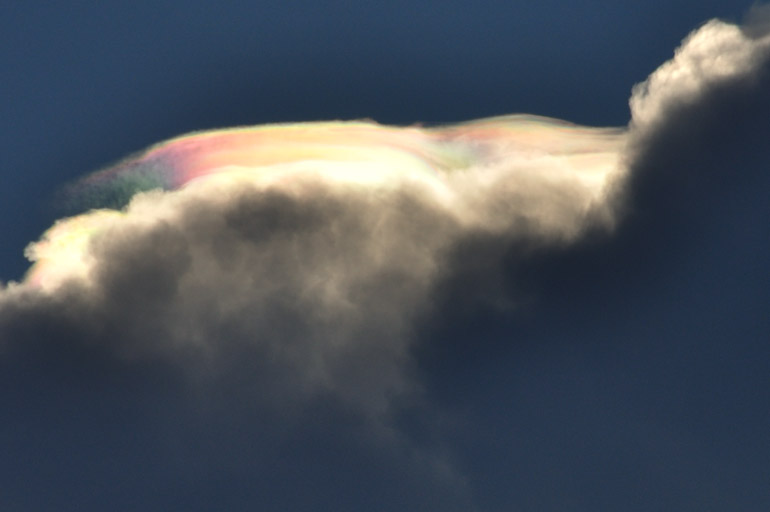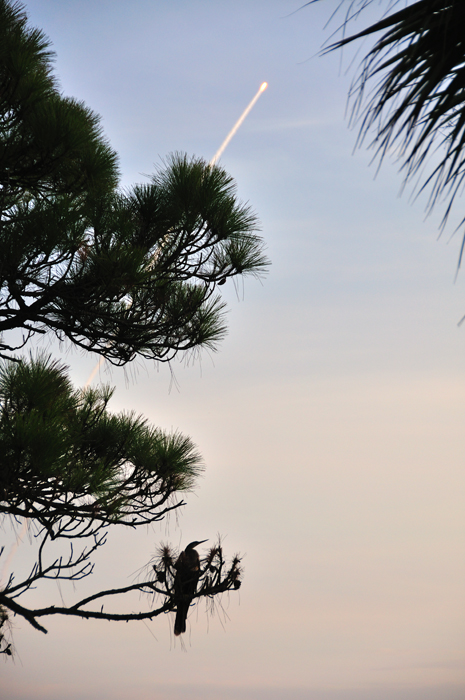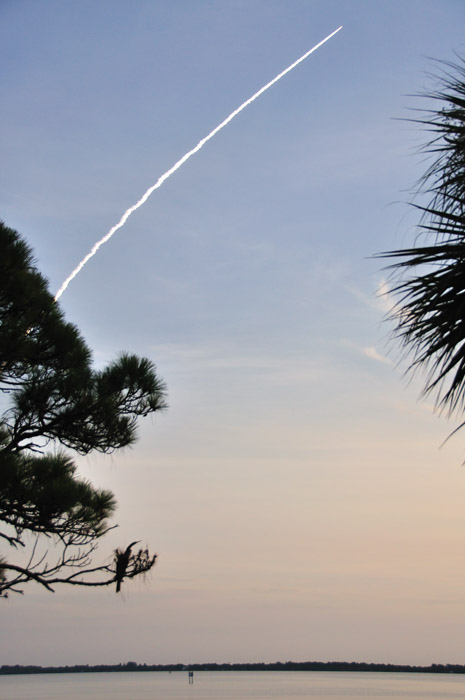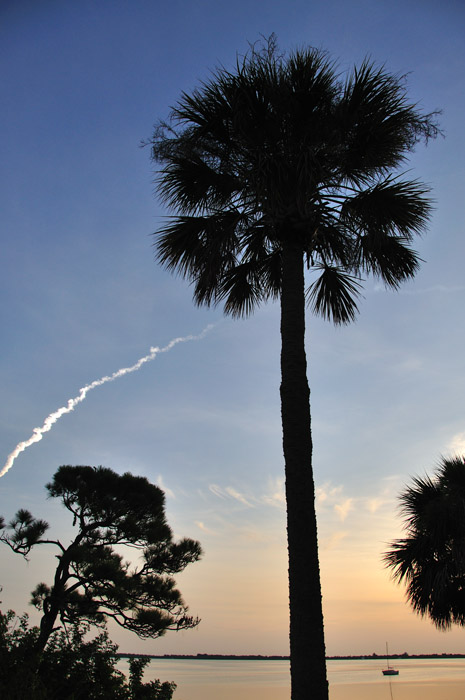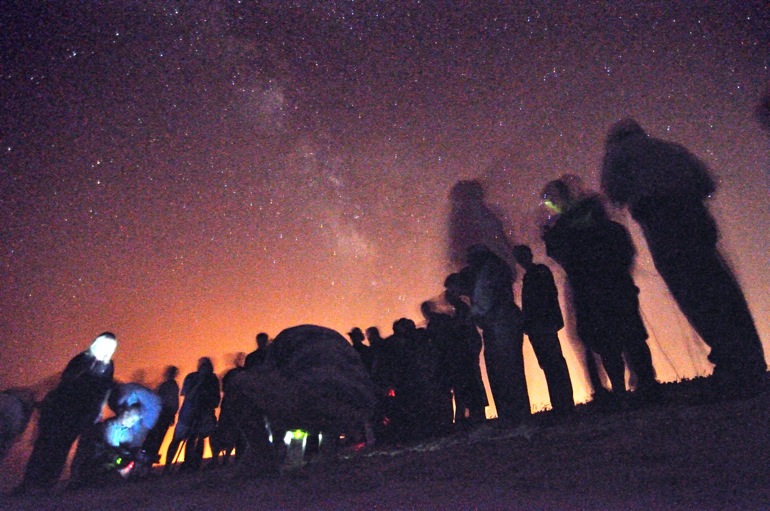Despite considerable ambient light on the horizon, the Milky Way Galaxy (see it better here) is visible behind the wildlife officials and journalists participating in the release of some of the turtles rescued from the Deepwater Horizon oil spill. It was the first time I had seen our little band of stars from a location in Brevard County. One of the biggest shortcomings of the Space Coast -- aside from its lack of lightning bugs, fall foliage, rugged terrain -- is the ambient light that blocks a view of the heavens.
During my childhood in Maine -- especially if I'd had a rough day -- I would walk outside my house and onto the dock over the lake and lie with my back on the sun-bleached 2-by-4s that seethed with water spiders. And I would stare at the stars.
The billions of stars.
And not a light in sight. No revving car engines, only hollering loons. Fish jumped and splashed down under the veil of darkness. I'd fight off mosquitoes and black flies, but it was worth it: just to look up and wonder, and to gasp in awe of a meteor. I couldn't blink. I couldn't miss anything.
Here, the stars seem countable. The city lights are just too much.
That's why last Monday's work shift was the best I've yet had here in Florida. Not because the story itself was amazing or exciting or especially ruthless and bloody, but because the setting reminded me of a better place. Despite the day's lousy ending and the ensuing lousy week, it made things bearable.
The assignment entailed a late-night excursion onto Canaveral National Seashore, a federal park that's closed to the public after 8 p.m. in the summer. The road to it is gated, and the beach itself is fenced off near Kennedy Space Center. But journalists were invited at 10 p.m. Monday to witness the release of hundreds of baby sea turtles relocated (via FedEx) from the Gulf of Mexico, where they would have been threatened by the oil spill.
From the outset, the assignment was pretty cool. (There's not a more apt descriptor than "cool," is there?) A park ranger blinked a flashlight at my car as it approached the gate. He checked my press badge and let me through. The next few miles of road meandered through the brackish marshes of northern Merritt Island.
I passed Kennedy Space Center's two shuttle launch pads and the Vehicle Assembly Building, its NASA "meatball" logo and its giant American flag bathed in white light.
Eyes glimmered in my headlights. In Maine, that means there's a deer, a moose or a bear up ahead. Here, it means there's an alligator up ahead. It crawled off the pavement.
Bugs -- basketball-size mosquitoes and behemoth moths -- collided with my windshield. My car got low on washer fluid.
As a regular thing, when I step out of my car at night, I first crane my neck backward and look at the sky. But when I parked at the seashore's Playalinda Beach -- notable among locals as a nudist attraction -- I saw something I had never seen here. At first, I thought it was a ribbon of thin clouds that stretched from the southwest horizon to the northeast horizon. But it wasn't moving.
It wasn't cloud cover. It seemed foreign.
It was foreign. It was downright extraterrestrial.
It was the Milky Way.
The stream of stars making up our spiral galaxy flowed from the mainland and emptied into the Atlantic Ocean. Only when I drove through the Keys last year had I seen this in Florida. Spotting it requires a dark sky.
On the beach, reporters and photographers from TV stations and newspapers -- including The Times of London -- watched turtles scamper to the ocean. They listened to biologists talk about the chances that this would work out for the baby critters. But I stood away from the crowd. I crouched, planted two knees into the sand and looked at the stars above the hubbub.
Then, a shooting star. And I made a wish: I wanted a tripod. I wanted to shoot the biologists and journalists focusing on the ground -- with the real star of the photo being the Milky Way in the sky behind them.
But as a rule, my wishes just don't come true, so I improvised. I planted my notebook into the sand, then set my camera on top. That stabilized my Nikon, then I boosted the ISO setting to make the shutter speed as quick as possible: four seconds. The resulting shots weren't technically awesome, but I didn't much mind. It's one of those sights that can't be shown through a lens anyway. I conveyed my enthusiasm and my observations in the article:
Our Milky Way Galaxy formed a spine of stars stretching across a clear sky -- a rare site for amateur astronomers here. A half moon had not yet risen. Twenty miles to the north, New Smyrna Beach glowed orange. To the south, the lights of Launch Complex 41, where Atlas V rockets lift off, were dim. Lightning intermittently flashed on the western horizon.
"This is one of the darker beaches on the East Coast," Jane Provancha, the NASA-contracted biologist supervising the effort, said as bats and mosquitoes battled over her head. "You can see with the night sky how really wonderful it is." (Full story)
I could have taken more time to gawk at the heavens, but I had to leave and pick up a cell phone signal somewhere back in civilization so I could file a story. When I was typing on my laptop while parked at a 7-Eleven back on the mainland, a minivan hit and crumpled my car's rear fender. $1,000 in damage. It was my first accident, though it was a lame one.
But it didn't bother me. I saw the sky and remembered what I had seen. I'm simple enough a person to know that no matter where I am on Earth, I can look up, forget and be happy.

